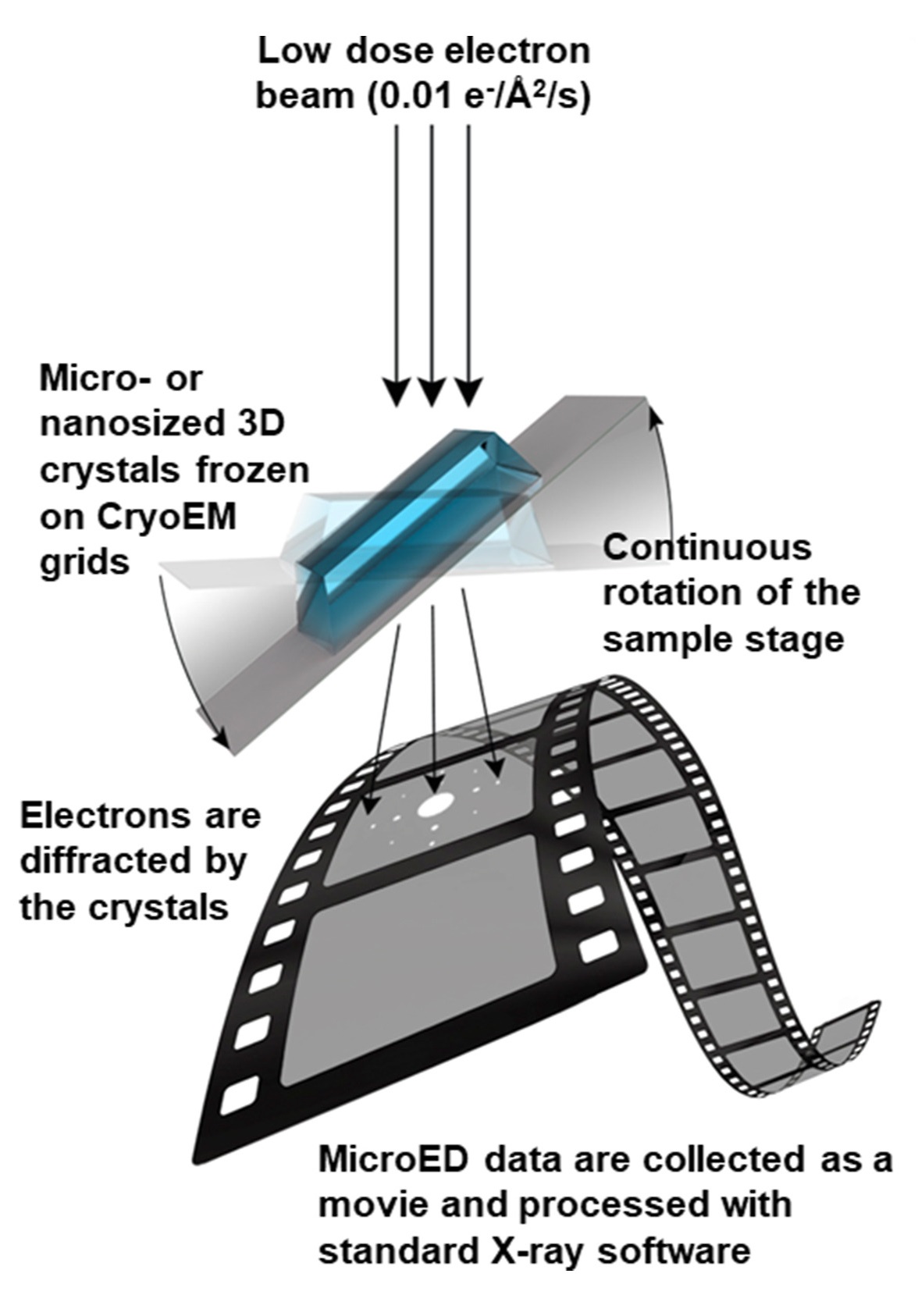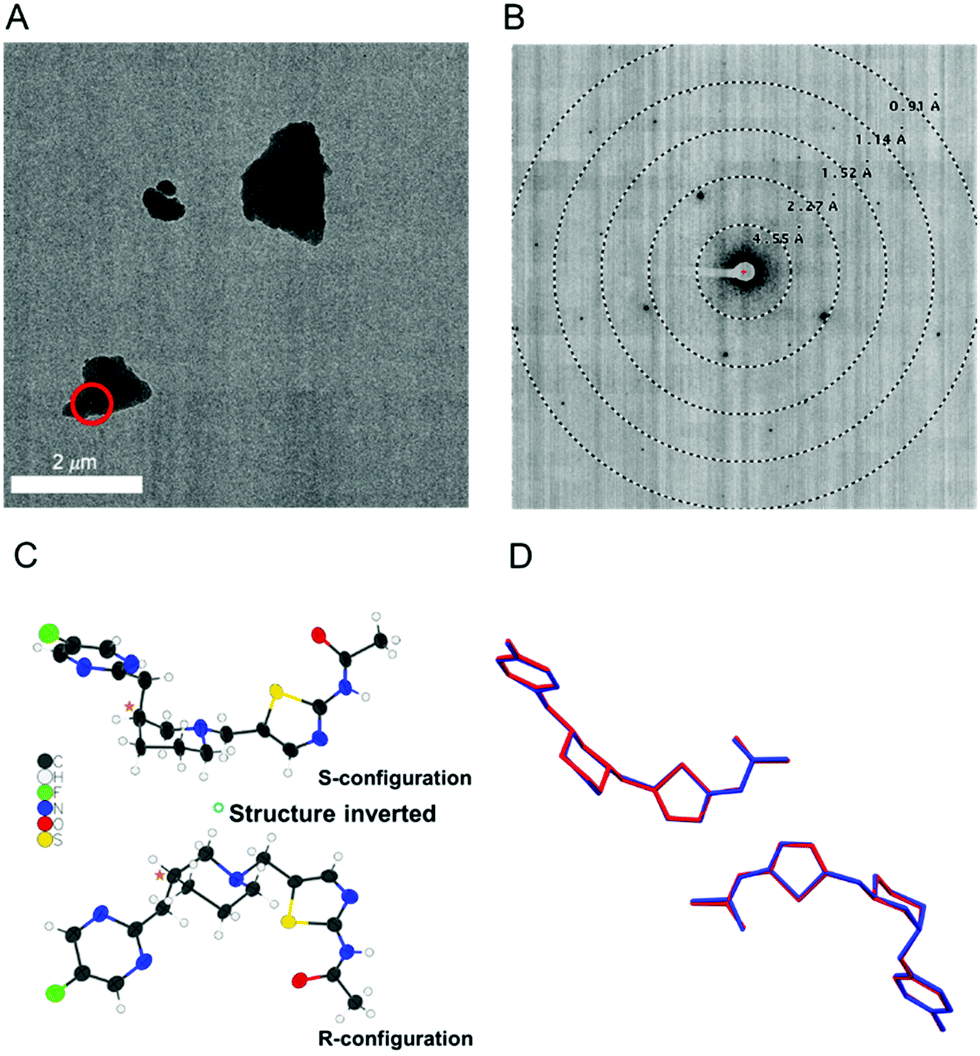MicroED for Solid State Testing Service
- In a cryo-electron microscope, a high-voltage electron beam is used to irradiate microcrystals at low dose, generating clear diffraction patterns.
- The sample is continuously rotated under the electron beam, allowing diffraction data to be recorded from multiple angles.
- Crystallographic methods—including indexing, integration, and phase reconstruction—are applied to computationally invert the diffraction data and build a 3D electron density map.
- An atomic-resolution structural model is then constructed, enabling the spatial conformation of the solid-state sample to be confirmed.
- Polymorph screening and structure determination
- Confirmation of new polymorphs, co-crystals, and salt forms
- Rapid structural verification of early-stage drug candidates
- Analysis of compounds that fail to yield large single crystals
- Monitoring of amorphous-to-crystalline phase transitions
- Investigation of crystallographic defects and impurity incorporation at the microstructural level
MicroED for Solid State Testing Service utilizes low-dose electron beams to collect three-dimensional diffraction data from nanoscale crystals and perform structural analysis. It is designed for solid-state samples that cannot be analyzed using traditional X-ray single-crystal diffraction, enabling researchers to obtain high-resolution crystallographic information with minimal sample quantities and verify and control solid forms effectively.
In the drug development process, solid-state characterization is essential for ensuring the quality, safety, and regulatory compliance of active pharmaceutical ingredients (APIs). In the early stages of drug discovery, many compounds exist only in microcrystalline or amorphous forms, making conventional single-crystal X-ray diffraction ineffective due to crystal size limitations. MicroED(microcrystal electron diffraction) overcomes this challenge by delivering atomic-resolution structural data from nanometer- to micrometer-sized crystals. It is especially suitable for samples with extremely limited quantities, submicron crystal dimensions, or challenging crystallization behavior, making it a vital structural tool in modern solid-state pharmaceutical research and crystal engineering.
MtoZ Biolabs offers MicroED for Solid State Testing Service to provide high-precision structural confirmation and polymorph analysis of solid-state drug compounds, natural products, small molecules, and crystalline impurities. This service is particularly well-suited for compounds that are difficult to crystallize or require rapid structural determination, supporting a range of applications from early-stage drug screening and polymorph development to definitive structural validation.
Technical Principles

Danelius E. et al. Structural Biology. 2023.
The core principles of MicroED are:
The scattering intensity of electron beams is much higher than that of X-rays, so MicroED is particularly suitable for extremely small amounts of highly radiation-sensitive microcrystalline samples. It can achieve crystal structure analysis at the nanocrystalline level and is widely used in solid-state research in the fields of medicine and materials.
Analysis Workflow
MicroED for Solid State Testing Service at MtoZ Biolabs follows a structured workflow:
1. Sample Evaluation and Preparation
Cryo-TEM grid preparation, sample screening, and plunge-freezing of suitable microcrystals.
2. Data Collection and Diffraction Imaging
Rotation electron diffraction patterns are acquired under low-dose conditions using high-resolution TEM.
3. Diffraction Data Processing and Structure Determination
Indexing, integration, and normalization of diffraction data;
Model building, structure refinement, and extraction of crystallographic parameters.
4. Reporting
Delivery of structural coordinate files, crystallographic parameters, representative images, and a complete structural analysis report.
Service Advantages
1. Nanocrystal Structure Resolution: Capable of solving structures from micro- and nanocrystals as small as <1 μm.
2. No Need for Single-Crystal Growth: Eliminates time-consuming crystallization, accelerating polymorph development.
3. Atomic-Level Resolution: Provides 3D structural details of active pharmaceutical ingredients (APIs), co-crystals, inclusion complexes, and salt forms.
4. Cross-Platform Compatibility: Integrates seamlessly with other solid-state analytical tools such as PXRD, DSC, and ssNMR.
Applications
MicroED for Solid State Testing Service is applicable in a variety of research and development contexts, including but not limited to:
FAQ
Q. What Types of Solid-State Samples are Suitable for MicroED Analysis?
MicroED is suitable for a wide range of small to medium molecular weight solid compounds, including microcrystalline APIs, co-crystals, salts, inclusion complexes, and impurity crystals. It is especially recommended for structural confirmation during early-stage polymorph screening.
Q. Can MicroED be Used for Polymorph Screening?
Yes. MicroED can rapidly resolve the crystal structures of candidate polymorphs, helping to identify the thermodynamically most stable or process-optimal form. It can also be used in conjunction with techniques such as PXRD for further verification.
Q. Is MicroED Still Applicable If the Sample Contains Large Particles or Impurities?
Yes. As long as a few suitable microcrystals are present, MicroED can be performed. We recommend sample refinement prior to submission (e.g., grinding, sieving). MtoZ Biolabs also offers assistance with sample pretreatment if needed.
Case Study
This study used MicroED technology, combined with a chiral salt formation strategy, to successfully resolve the microcrystalline salt structure of a preclinical drug candidate molecule, and for the first time determined its absolute configuration to be R-type in the absence of large-scale single crystals. In the study, the researchers formed a chiral salt with the chiral API and d-malic acid of known configuration, obtained its three-dimensional crystal structure through MicroED, and used the chiral counter ion as an internal reference to achieve configuration judgment. This result verifies the feasibility and accuracy of MicroED combined with chiral-assisted strategy in determining the absolute configuration of drugs in solid powder samples, providing an efficient and reliable new method for the development of chiral drugs.

Wang B. et al. Chemical Communications. 2022.
How to order?







